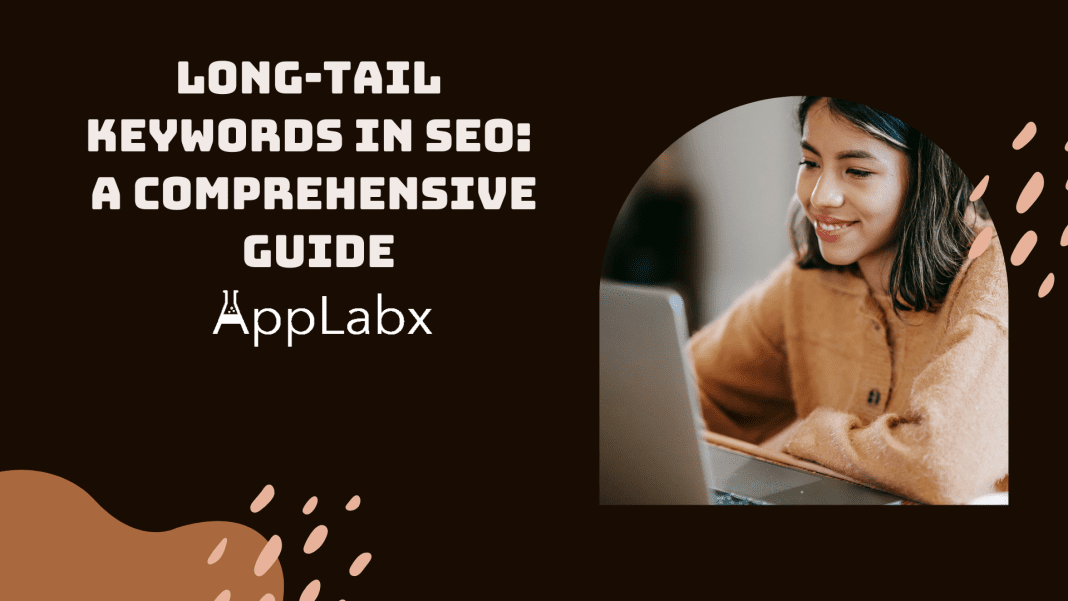Key Takeaways
- Precision Unleashed: Long-tail keywords empower SEO precision, aligning your content precisely with user intent and catering to niche queries for enhanced visibility.
- Adaptability Wins: Navigate the evolving SEO landscape by adapting to emerging trends, from voice search to AI integration, ensuring your long-tail strategy remains at the forefront.
- Art Meets Science: Success lies at the intersection of data-driven strategies and compelling content. Craft valuable, engaging content while strategically optimizing for long-tail keywords to achieve optimal digital visibility.
Welcome to the ultimate guide that will unravel the mysteries and unveil the power of long-tail keywords in the realm of Search Engine Optimization (SEO).
In the vast landscape of digital marketing, understanding the nuances of long-tail keywords is akin to discovering the secret formula for unlocking your website’s true potential.
In this comprehensive guide, we embark on a journey into the depths of SEO strategy, dissecting the significance of long-tail keywords and equipping you with the knowledge to propel your online presence to new heights.
As the digital arena becomes increasingly competitive, mastering the art of long-tail keywords is not just a choice but a necessity for businesses and content creators striving to stand out in the vast expanses of the internet.
Unveiling the Essence of Long-Tail Keywords
Before delving into the intricacies, let’s demystify what long-tail keywords truly are.
Imagine them as the unsung heroes of search queries – phrases that may not boast the astronomical search volumes of their short-tail counterparts but wield a potency that transcends mere numbers.
Long-tail keywords are the specific, often niche, phrases that users type into search engines when they are on a mission – a mission to find precisely what they’re looking for.
Why Do Long-Tail Keywords Matter in SEO?
In a digital universe dominated by the Google algorithm, the significance of long-tail keywords cannot be overstated.
As search engines become more sophisticated, user intent takes center stage, and this is precisely where long-tail keywords shine.
They are the breadcrumbs leading your target audience directly to your virtual doorstep, offering a pathway to not just traffic but qualified and conversion-ready visitors.
This comprehensive guide is your compass through the evolving landscape of SEO, where the understanding and strategic implementation of long-tail keywords can be the catalyst for exponential growth.
We’ll unravel the benefits, explore the methodologies to identify these hidden gems and equip you with the tools to seamlessly integrate them into your content strategy.
Beyond the Basics: The Profound Benefits of Long-Tail Keywords
As we navigate through this guide, you’ll discover that long-tail keywords are not just modifiers to sprinkle in your content but powerful assets that can transform your SEO game.
Long-tail keywords are the linchpin in building a robust online presence, from enhancing relevance and driving targeted traffic to minimizing competition and elevating conversion rates.

Unlocking the Treasure Trove: How to Identify Long-Tail Keywords
But how do you unearth these valuable keywords amidst the vast sea of digital content?
Fear not!
We’ll guide you through the intricacies of keyword research tools, demystify user intent, and illuminate the path to identifying long-tail keywords that align seamlessly with your content and business objectives.
Crafting Content that Speaks the Language of Long-Tail Keywords
Integration is key, and our guide doesn’t stop at identification.
We delve into the art of seamlessly incorporating long-tail keywords into various content types, ensuring your message resonates with your audience while appeasing the ever-watchful eyes of search engine algorithms.
As we embark on this enlightening journey, brace yourself for a visionary exploration of future trends in long-tail keyword optimization. This guide isn’t just a walkthrough; it’s a roadmap to success in the dynamic landscape of SEO.
Are you ready to revolutionize your approach to SEO and witness the transformative power of long-tail keywords? Join us as we unravel the intricacies, debunk myths, and equip you with the tools to not just survive but thrive in the digital wilderness.
Welcome to the Comprehensive Guide on Long-Tail Keywords in SEO—a game-changer for the discerning digital marketer.
Before we venture further, we like to share who we are and our digital experiences.
About AppLabx
From developing a solid marketing plan to creating compelling content, optimizing for search engines, leveraging social media, and utilizing paid advertising, AppLabx offers a comprehensive suite of digital marketing services designed to drive growth and profitability for your business.
AppLabx is well known for helping companies and startups leverage long-tail keywords in SEO to drive web traffic to their websites and web apps.
At AppLabx, we understand that no two businesses are alike. That’s why we take a personalized approach to every project, working closely with our clients to understand their unique needs and goals, and developing customized strategies to help them achieve success.
Long-Tail Keywords in SEO: A Comprehensive Guide
- Understanding Long-Tail Keywords
- Benefits of Using Long-Tail Keywords
- How to Identify Long-Tail Keywords
- Incorporating Long-Tail Keywords in Content
- Long-Tail Keywords and Content Types
- Monitoring and Adjusting Long-Tail Keyword Strategy
- Future Trends in Long-Tail Keyword Optimization
1. Understanding Long-Tail Keywords
In the vast landscape of SEO, understanding the intricacies of long-tail keywords is paramount.
Let’s delve into what makes these keywords unique, their characteristics, and why they hold the key to unlocking targeted traffic and enhancing your online visibility.
Defining Long-Tail Keywords and Their Characteristics
Long-tail keywords are more than just extended phrases; they represent specific and often niche queries that users input into search engines.
Unlike short-tail keywords, which are broader and more competitive, long-tail keywords are highly targeted, offering a more granular view of user intent.
Example: While “running shoes” is a short-tail keyword, “best long-distance running shoes for flat feet” is a long-tail keyword. The latter is not only more specific but also reflects a user closer to the point of conversion.

Distinguishing Long-Tail from Short-Tail Keywords
Short-tail keywords often consist of one to three words and have higher search volumes.
Long-tail keywords, on the other hand, typically contain three or more words, are more specific, and cater to a narrower audience.
Example: According to FasterCapital, long-tail keywords allow businesses to target a more specific audience with higher intent.
Long-tail keywords play a crucial role in SEO strategy due to their ability to align with user intent.
The Significance of User Intent
Understanding user intent is pivotal when it comes to long-tail keywords.
Users employing specific queries are often in the later stages of the buying cycle, seeking detailed information, solutions, or products. Aligning your content with this intent can significantly improve engagement and conversion rates.
Example: Consider a user searching for “best budget DSLR cameras for beginners.” This query indicates a clear intent to purchase, and tailoring your content to address this intent can lead to higher conversion rates.
Navigating the Competitive Landscape
Long-tail keywords present an opportunity to navigate the competitive SEO landscape more effectively.
With less competition for these specific queries, businesses and content creators can establish a stronger foothold in their niche markets.
Example: A study compared the performance of long-tail and short-tail keywords and found that long-tail keywords tend to have lower search terms but higher conversion rates.
In SEO, understanding long-tail keywords is not merely an option but a strategic imperative.
As we journey deeper into this comprehensive guide, we will explore how to leverage the power of long-tail keywords to propel your digital presence to new heights.
Stay tuned for insights into the benefits and strategic implementation of these targeted phrases.
2. Benefits of Using Long-Tail Keywords
Long-tail keywords are not just a niche aspect of SEO; they are a dynamic force that can reshape your digital strategy.
Let’s delve into the profound benefits of incorporating long-tail keywords into your SEO arsenal and explore real-world examples that underscore their impact.
Enhanced Relevance
Long-tail keywords offer a level of specificity that aligns closely with user intent, providing more relevant search results.
This heightened relevance not only improves user satisfaction but also signals to search engines that your content precisely addresses the user’s query.
Example: For a fitness blog, targeting the long-tail keyword “low-impact exercises for older people” is more relevant than a generic term like “exercises.” This specificity ensures that the content caters directly to the needs of the intended audience.
Targeted Traffic Acquisition
The specificity of long-tail keywords directs traffic that is not only more qualified but also more likely to convert. By attracting users with clear intent, you’re not just increasing traffic numbers but bringing in visitors genuinely interested in what you offer.
Example: Long-tail keywords contribute to higher conversion rates, as cited by Simple Machines. They have an average conversion rate of 36%. They generate visitors who turn into paying customers 2.5 times more than primary keywords do, as cited by Digital Resource.

Lower Competition
In the competitive landscape of SEO, targeting short-tail keywords can be an uphill battle due to intense competition. Long-tail keywords, however, often have lower competition, allowing your content to stand out in search engine results more effectively.
Example: A study reveals that 70% of all web searches are long-tail keywords. Focusing on these less competitive terms can give your content a better chance to rank and be discovered. This means that you can identify a much larger number of keywords that are much less competitive.
Higher Conversion Rates
The specificity of long-tail keywords not only attracts the right audience but also positions your content closer to the point of conversion.
Users searching for detailed, specific information are often further along the buyer’s journey, making them more likely to convert.
Example: Consider a user searching for “best organic dog food for small breeds.” If your pet supply store aligns with this query, the chances of conversion are higher compared to a generic search for “dog food.”
3. How to Identify Long-Tail Keywords
Identifying effective long-tail keywords is the cornerstone of a successful SEO strategy.
In this section, we’ll explore the methodologies, tools, and techniques that empower you to pinpoint those specific phrases that can elevate your content and attract a highly engaged audience.
Utilizing Keyword Research Tools
Keyword research tools are invaluable in the quest for long-tail keywords.
These tools provide insights into search volumes, competition, and related terms, helping you identify specific phrases that align with your content goals.
- Google Keyword Planner: A stalwart in keyword research, Google Keyword Planner provides data on search volumes, and competition, and suggests related keywords. It’s an excellent starting point for understanding the landscape of potential long-tail keywords.

- SEMrush: SEMrush goes beyond basic keyword data, offering in-depth insights into competitors’ strategies, organic and paid search data, and keyword trends. It’s a powerful tool to identify long-tail keywords with lower competition.

- Ahrefs: Ahrefs not only helps identify long-tail keywords but also provides comprehensive backlink analysis and content gap analysis. This multifaceted approach can refine your keyword strategy for maximum impact.

Analyzing User Intent
Understanding the intent behind user queries is crucial when identifying long-tail keywords. By putting yourself in the shoes of your target audience, you can decipher the specific questions or concerns they may have.
- Consider the Buyer’s Journey: Recognize where your audience is in the buyer’s journey. Are they in the awareness, consideration, or decision stage? Tailor your long-tail keywords to address their needs at each stage.
- Leverage “Who,” “What,” “Where,” “When,” and “How” Queries: Long-tail keywords often take the form of specific questions. For instance, “How to lose weight without exercising” or “Where to buy sustainable fashion online.” Crafting content that answers these questions caters directly to user intent.
Mining Analytics Data for Insights
Your website’s analytics data holds valuable clues about the terms used to find your content. Analyze this data to identify patterns and uncover potential long-tail keywords.
- Google Analytics: Dive into the Search Queries report in Google Analytics to discover the terms used to land on your site. Look for patterns in longer, more specific queries that indicate user intent.
- Search Console: Google Search Console provides valuable data on the keywords for which your site appears in search results. Identify longer queries that drive organic traffic and tailor your content to enhance visibility for these terms.
Long-Tail Keyword Examples and Formulas
Examining examples of effective long-tail keywords can illuminate the principles behind their formulation.
- Example 1: Short-tail keyword: “smartphones.” Long-tail keyword: “best budget smartphones for photography.”
- Example 2: Short-tail keyword: “travel destinations.” Long-tail keyword: “family-friendly travel destinations in Europe for summer.”
Competitor Analysis for Inspiration
Analyzing the strategies of your competitors can provide valuable insights into effective long-tail keywords within your niche.
- Identify Competitors: Identify key competitors in your industry or niche.
- Analyze Content and Keywords: Examine their content to identify the keywords they are targeting. Look for gaps where you can provide more comprehensive or specialized information.
Leveraging Social Media and Online Communities
Social media platforms and online communities are treasure troves of insights into the language and queries your audience uses.
- Monitor Conversations: Pay attention to discussions related to your industry or niche on platforms like X (Twitter), Reddit, or industry-specific forums. Identify recurring themes and questions.
- Engage with Your Audience: Directly engage with your audience through social media. Ask questions, conduct polls, and gather feedback to understand the language they use and the topics they are interested in.
4. Incorporating Long-Tail Keywords in Content
Now that we’ve uncovered the art of identifying long-tail keywords, the next crucial step is seamlessly integrating them into your content.
In this section, we’ll explore best practices, on-page SEO strategies, and optimal keyword density to ensure your content not only ranks well but resonates with your target audience.
On-Page SEO Best Practices
On-page SEO is the foundation upon which your content’s visibility rests. Properly incorporating long-tail keywords into your on-page elements enhances search engine understanding and improves the overall user experience.
- Title Tags: Place your long-tail keyword naturally within the title tag. This not only signals the topic of your content to search engines but also entices users to click.
- Example: If your long-tail keyword is “best hiking boots for women with high arches,” an optimized title tag could be “Discover the Best Hiking Boots for Women with High Arches – A Comprehensive Guide.”
- Meta Descriptions: Craft compelling meta descriptions that include the long-tail keyword. While meta descriptions don’t directly impact rankings, they influence click-through rates.
- Example: “Explore our selection of the best hiking boots for women with high arches. Find comfort and style for your outdoor adventures. Discover more now.”
- Header Tags (H1, H2, H3): Use header tags to structure your content logically. Incorporate long-tail keywords in subheadings (H2, H3) to break down content and improve readability.
- Example: Subheading (H2): “Choosing the Right Hiking Boots for Women with High Arches”

Creating Compelling Content Around Long-Tail Keywords
While strategic placement is essential, the core of your content must be engaging and valuable. Craft content that not only satisfies search intent but also keeps your audience captivated.
- In-Depth Information: Provide comprehensive information about the long-tail keyword. Address related questions and concerns to establish authority on the topic.
- Example: For the long-tail keyword “best budget smartphones for photography,” cover aspects like camera specifications, performance, and user reviews.
- Use of Multimedia: Enhance your content with multimedia elements like images, infographics, and videos. This not only improves user engagement but also provides opportunities to incorporate variations of your long-tail keyword in alt text and captions.
- Example: Include images of the recommended hiking boots, showcasing different angles and features, with alt text such as “best hiking boots for women with high arches – side view.”
Optimal Keyword Density
While avoiding keyword stuffing, maintaining an optimal keyword density helps search engines understand the focus of your content.
- Keyword Placement: Naturally integrate the long-tail keyword throughout the content, focusing on the introduction, conclusion, and strategically within the body.
- Example: In a blog about “family-friendly travel destinations in Europe for summer,” subtly include the long-tail keyword in sentences like, “Planning a summer getaway? Explore these family-friendly travel destinations in Europe.”
- Variations and Synonyms: Use variations and synonyms of your long-tail keyword to prevent redundancy and appeal to a broader range of search queries.
- Example: Instead of repetitively using “best budget smartphones for photography,” mix in phrases like “affordable camera phones” or “budget-friendly smartphones with good cameras.”
User Experience and Readability
Prioritize the user experience by ensuring your content is readable, accessible, and caters to the diverse needs of your audience.
- Mobile Optimization: With the increasing prevalence of mobile searches, ensure your content is optimized for mobile devices. Google favors mobile-friendly websites in its rankings.
- According to Statista, mobile devices (excluding tablets) generated 58.33 per cent of global website traffic in the first quarter of 2023.
- Readable Format: Break down your content into digestible sections with descriptive subheadings. Utilize bullet points and numbered lists for clarity.
- Example: In a guide about “essential kitchen gadgets for busy moms,” use subheadings like “Time-Saving Appliances” and “Organizational Tools” for easy navigation.
5. Long-Tail Keywords and Content Types
As we explore the synergy between long-tail keywords and different content types, it becomes evident that strategic integration is key to maximizing their impact.
In this section, we’ll delve into the nuances of using long-tail keywords across various content formats, backed by examples and data-driven insights.
Long-Tail Keywords in Blog Posts
Blog posts are dynamic platforms where long-tail keywords can shine, providing in-depth insights and addressing specific queries.
- Educational Guides: Craft comprehensive guides around long-tail keywords, offering valuable information and solutions.
- Example: For the long-tail keyword “natural remedies for insomnia,” create a blog post detailing various natural approaches, their benefits, and how to incorporate them into a routine.
- Answering Questions: Use blog posts to directly answer specific questions posed by users through long-tail queries.
- To rank well for questions typed into Google you have to create great responses that add value to the user. Queries can start with “how,” “what,” “where,” and “why” for content optimization.
Long-Tail Keywords in Product Descriptions
Optimizing product descriptions with long-tail keywords can enhance the discoverability of your products and attract highly relevant traffic.
- Detailed Product Attributes: Incorporate specific product details and features within descriptions, aligning with potential customer queries.
- Example: For a product like “waterproof hiking boots for women,” ensure the product description highlights key features like materials, waterproof technology, and suitable terrains.
- Size and Color Variations: If applicable, include size and colour variations in product descriptions to cater to users looking for specific options.
Long-Tail Keywords in Landing Pages
Landing pages serve as entry points to your website, and optimizing them with long-tail keywords can significantly impact user engagement and conversion rates.
- Targeting Local Keywords: If your business operates in specific locations, incorporate long-tail keywords with local modifiers in landing page content.
- Example: For a bakery in New York, target the long-tail keyword “best custom birthday cakes in New York City” in the landing page content.
- Call to Action (CTA) Alignment: Ensure that the long-tail keywords seamlessly align with your landing page’s call-to-action, guiding users toward desired actions.
Long-Tail Keywords in Multimedia Content
Multimedia elements, including images, videos, and infographics, present unique opportunities to integrate long-tail keywords and enhance the visual appeal of your content.
- Image Alt Text: Use descriptive alt text for images, incorporating variations of your long-tail keywords.
- Example: For an infographic about “easy home workouts for beginners,” use alt text like “infographic displaying simple home exercises for beginners.”
- Video Descriptions and Tags: In video content, optimize descriptions and tags with relevant long-tail keywords to improve discoverability on platforms like YouTube.
- In a survey, 91% of businesses use video as a marketing tool.

Long-Tail Keywords in Podcasts and Audio Content
As the popularity of audio content rises, optimizing podcast descriptions and episode titles with long-tail keywords can enhance discoverability.
- Episode Summaries: Craft detailed episode summaries that naturally incorporate long-tail keywords, making your podcast more accessible through search.
- Example: For a health and wellness podcast, summarize an episode about “mindfulness meditation for stress relief” with a keyword-rich description.
- Transcripts and SEO: Including episode transcripts not only improves accessibility but also provides search engines with more content to index, boosting SEO.
- Data: According to Podcast Insights, as of 2021, there are over 2 million podcasts and more than 48 million episodes available.
6. Monitoring and Adjusting Long-Tail Keyword Strategy
In the dynamic world of SEO, a proactive approach to monitoring and adjusting your long-tail keyword strategy is imperative for sustained success.
This section explores the tools, metrics, and methodologies that empower you to stay ahead of the curve, backed by real-world examples and data-driven insights.
Regular Keyword Audits
Performing regular keyword audits allows you to assess the performance of your chosen long-tail keywords and identify opportunities for optimization.
- Use Keyword Research Tools: Leverage tools like SEMrush, Ahrefs, and Google Keyword Planner to reevaluate the search volume, competition, and relevance of your chosen long-tail keywords.
- Example: If your initial research focused on “best budget smartphones for photography,” a keyword audit may reveal emerging terms like “affordable camera phones 2023,” signaling a shift in user search behavior.
- Identify New Trends: Stay attuned to industry trends and changes in user behavior that may impact the popularity or relevance of specific long-tail keywords.
- According to a report, 15% of all searches on Google are entirely new, highlighting the constant evolution of user queries.
Keeping Up with Industry Trends
The digital landscape is ever-evolving, and staying informed about industry trends is crucial for adapting your long-tail keyword strategy.
- Industry News and Publications: Regularly read industry-specific publications, blogs, and news to stay abreast of emerging trends and shifts in user preferences.
- Example: In the tech industry, the rise of new camera technologies might influence a shift in long-tail keywords from “best budget smartphones for photography” to “smartphones with advanced camera features.”
- Social Listening: Monitor social media platforms for discussions, feedback, and trending topics related to your industry or niche.
- Data: As of October 2023, there were 5.3 billion internet users worldwide, which amounted to 65.7 percent of the global population.
Adapting to Algorithm Changes
Search engine algorithms continually evolve, impacting how content is ranked. Adapting your long-tail keyword strategy to algorithmic changes is crucial for maintaining visibility.
- Google Algorithm Updates: Keep a watchful eye on major updates from search engines, particularly Google, and understand how they may influence ranking factors.
- Example: Google’s BERT algorithm update emphasizes understanding user intent, necessitating adjustments in long-tail keywords to align more closely with natural language queries.
- SEO Software Alerts: Utilize SEO software that provides alerts or notifications about significant algorithmic changes, allowing you to adjust your strategy promptly.
- It is reported that Google makes thousands of algorithm updates each year, emphasizing the need for continuous monitoring and adaptation.
Analyzing User Behavior and Search Console Data
Understanding how users interact with your content provides valuable insights for refining your long-tail keyword strategy.
- Google Search Console: Regularly analyze the data in Google Search Console to identify the queries for which your content is appearing in search results.
- Example: If your content about “natural remedies for insomnia” is receiving impressions for queries related to “sleep aids,” it may indicate an opportunity to optimize for the latter term.
- User Engagement Metrics: Monitor user engagement metrics such as click-through rates (CTR) and time on page to gauge how well your content resonates with visitors.
- Data: According to Backlinko, the #1 result in Google’s organic search results has an average CTR of 27.6%.
Competitor Analysis and Benchmarking
Analyzing your competitors’ strategies provides valuable benchmarks and insights into emerging trends.
- Identify Competitor Success: Examine competitors who consistently perform well in your industry. Identify the long-tail keywords they are targeting and assess their content strategies.
- Example: If a competitor in the fitness industry is gaining traction with content about “home workout routines for beginners,” it may prompt you to explore similar long-tail keywords.
- Content Gap Analysis: Identify gaps in competitors’ content that you can fill with targeted, well-optimized content.
- Data: According to Backlinko, conducting a content gap analysis can reveal opportunities to create content that stands out in search results.
7. Future Trends in Long-Tail Keyword Optimization
Voice Search and Conversational Keywords
As voice search technology becomes more prevalent, the nature of user queries is shifting towards natural language and conversational patterns.
- Impact of Voice Search: With the rise of virtual assistants like Siri and Alexa, users are increasingly using voice commands to perform searches.
- It is predicted that by 2024, the global voice recognition market will be worth $26.8 billion, and there will be 8 billion voice-enabled digital assistants.
- Example: Instead of typing “best Italian restaurants,” users might voice search with a natural query like “What are the best Italian restaurants near me right now?”
Semantic Search and User Intent
Search engines are becoming more adept at understanding the context and intent behind user queries, emphasizing the importance of semantic search.
- Semantic SEO Strategies: Optimizing content for semantic search involves focusing on the meaning and intent behind keywords rather than exact matches.
- Example: Instead of targeting a single long-tail keyword like “graphic design software,” content could be optimized to address related terms like “tools for creating digital graphics” or “software for amateur graphic designers.”
- User Intent Modeling: Understanding user intent becomes central to long-tail optimization as search engines aim to deliver results that best match the user’s underlying purpose.
- In fact, when it comes to ranking results, BERT will help Search better understand one in 10 searches in the U.S. in English.
AI and Machine Learning in Keyword Analysis
The integration of artificial intelligence (AI) and machine learning (ML) technologies is reshaping how marketers analyze and leverage long-tail keywords.
- Predictive Analytics: AI-powered tools can predict emerging trends and user behaviour, allowing marketers to proactively optimize content for upcoming long-tail keywords.
- Example: AI algorithms may predict that the term “sustainable travel essentials” will gain popularity, prompting content creators to proactively integrate this long-tail keyword.
- Dynamic Keyword Strategies: Machine learning algorithms can dynamically adjust keyword strategies based on real-time data, user interactions, and industry shifts.

Visual and Image Search Optimization
As visual search technologies advance, optimizing for long-tail keywords in image descriptions and alt text is gaining significance.
- Visual Search Engines: Platforms like Pinterest and Google Images are evolving to support visual search, allowing users to search by images instead of text.
- Example: Optimizing alt text with descriptive long-tail keywords like “modern kitchen interior design ideas” for images on a home decor website.
- E-commerce Impact: For e-commerce sites, optimizing product images with long-tail keywords can enhance visibility in visual search results.
Localized and Hyper-Specific Long-Tail Keywords
The increasing focus on local search and hyper-specific queries is shaping the landscape of long-tail keyword optimization.
- Local SEO Emphasis: Local businesses benefit from targeting hyper-specific long-tail keywords with geographic modifiers to cater to localized searches.
- Example: A bakery in Los Angeles might optimize for “custom birthday cakes in downtown LA” to capture local customers.
- Mobile and “Near Me” Searches: The prevalence of mobile devices has led to a surge in “near me” searches, emphasizing the need for localized long-tail optimization.
Interactive and Multimedia Content Optimization
The future of long-tail keyword optimization extends beyond text-based content, encompassing interactive and multimedia elements.
- Optimizing Video Content: Incorporating long-tail keywords in video titles, descriptions, and transcripts for improved visibility in video search results.
- Example: A cooking channel may optimize for the long-tail keyword “easy vegetarian dinner recipes” in video titles and descriptions.
- Interactive Content SEO: As interactive content like quizzes and polls becomes more prevalent, optimizing for long-tail keywords within these formats becomes essential.
- In a report, 62% of B2B marketers used interactive content.
Conclusion
In this comprehensive guide, we embarked on a journey through the intricate world of long-tail keywords in SEO, uncovering their significance, strategies for identification, incorporation into various content types, and a glimpse into future trends.
As we conclude, let’s distil the key takeaways and actionable insights that make long-tail keyword optimization a cornerstone of a robust SEO strategy.
The Power of Precision: Understanding Long-Tail Keywords
Long-tail keywords aren’t just clusters of words; they are the key to unlocking precision in user intent.
By delving into specific, niche queries, businesses and content creators can align their offerings with the exact needs of their target audience.
Whether it’s a local business targeting “custom birthday cakes in downtown LA” or a blog addressing “natural remedies for insomnia,” the power of precision lies in the specificity of long-tail keywords.
Strategic Implementation: Incorporating Long-Tail Keywords Across Content Types
Our exploration extended to the practicalities of incorporating long-tail keywords across various content formats.
From blog posts and product descriptions to landing pages, multimedia content, and emerging platforms like podcasts, the strategic placement of long-tail keywords enhances visibility and engagement.
The nuanced approach of aligning keywords with user intent and adapting to evolving content types ensures that your content remains not only optimized for search engines but also resonant with your audience.
The Dynamic Landscape: Adapting to Future Trends in Long-Tail Keyword Optimization
As we peer into the future of SEO, several trends are poised to reshape long-tail keyword optimization.
The rise of voice search, the influence of semantic SEO, the integration of AI and machine learning, the importance of visual and localized searches, and the evolution of interactive content all underscore the need for adaptability.
The forward-looking marketer recognizes that staying ahead involves embracing these trends, optimizing for evolving user behaviors, and leveraging emerging technologies to maintain a competitive edge.
Continuous Monitoring and Adjustment: A Pillar of Long-Tail Success
Long-tail keyword optimization is not a one-time endeavour; it’s a dynamic, ongoing process.
Regular keyword audits, staying informed about industry trends, adapting to algorithm changes, analyzing user behaviour, and benchmarking against competitors constitute the pillars of a proactive strategy.
As the digital landscape evolves, the successful optimization of long-tail keywords hinges on the ability to monitor, analyze, and adjust strategies to align with changing user behaviours and search engine algorithms.
The Intersection of Art and Science: Crafting Compelling Content
At the heart of long-tail keyword optimization lies the intersection of art and science.
While data-driven strategies and SEO best practices guide the selection and placement of keywords, the art lies in crafting compelling, valuable content.
Whether it’s a blog answering specific user queries, a product description offering detailed insights, or a multimedia presentation captivating your audience, the marriage of strategic optimization and engaging content creates a harmonious digital presence.
Embarking on Your Long-Tail Journey: Actionable Insights Await
As we conclude this comprehensive guide, armed with insights into the intricacies of long-tail keywords, their strategic implementation, and a glimpse into the future of SEO, you are well-equipped to embark on your long-tail journey.
Whether you are a seasoned marketer refining your strategy or a newcomer navigating the complexities of SEO, the roadmap laid out in this guide provides a valuable compass.
Remember, long-tail keywords are not just strings of words; they are the bridges that connect your content with the specific needs and queries of your audience.
As the digital landscape continues to evolve, your ability to adapt, innovate, and leverage the power of long-tail keywords will be pivotal in shaping a successful digital presence.
So, embrace the art and science of long-tail keyword optimization, stay vigilant in the ever-changing SEO landscape, and let the precision of your content resonate with the hearts and minds of your audience.
The journey doesn’t end here; it’s an ongoing exploration into the dynamic realm of digital visibility. Safe travels on your long-tail adventure!
If you are looking for a top-class digital marketer, then book a free consultation slot here.
If you find this article useful, why not share it with your friends and business partners, and also leave a nice comment below?
We, at the AppLabx Research Team, strive to bring the latest and most meaningful data, guides, and statistics to your doorstep.
To get access to top-quality guides, click over to the AppLabx Blog.
People also ask
What are long-tail keywords in SEO?
Long-tail keywords in SEO are specific and niche phrases, usually consisting of three or more words, tailored to meet the unique search queries of users. They offer targeted solutions, aligning content precisely with user intent, and often result in higher conversion rates due to their specificity.
Are long-tail keywords easier to rank for?
Yes, long-tail keywords are generally easier to rank for. With lower competition, these specific, niche phrases allow businesses to target a more defined audience, increasing the chances of visibility and ranking on search engine results pages.
Do long-tail keywords have a higher CTR?
Yes, long-tail keywords often yield a higher Click-Through Rate (CTR). Their specificity aligns with user intent, attracting more relevant traffic. Users searching with detailed queries are more likely to click on content that precisely addresses their needs, resulting in an increased CTR.
































